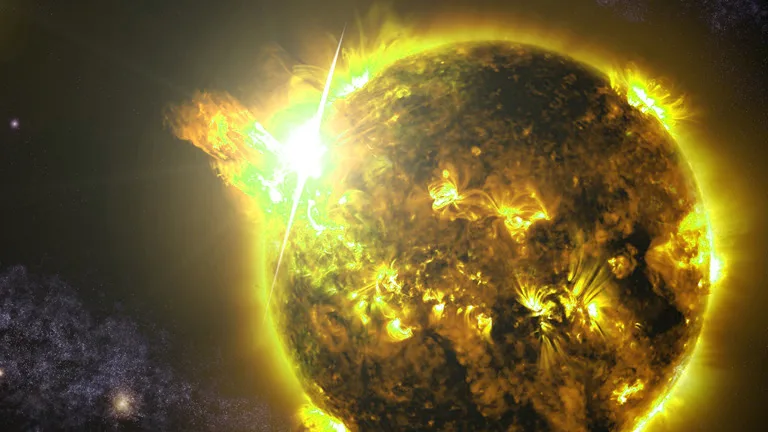
The Sun may blast out dangerous 'superflare' within next 100 years
So called "superflares" are rare for our Sun, but they could still pose a threat to us
Our Sun is an active star, emitting solar flares all the time, and occasionally blasting out an extremely powerful one, but a new study has revealed there's a chance, however small, that it could unleash a dangerous 'superflare', potentially within the next 100 years or so.
By examining our Sun and stars out in the galaxy, astronomers have determined that stars like our Sun typically start off very active, as they rapidly rotate after forming. These 'young suns' are capable of blasting out incredibly powerful flares - thousands of times more powerful than anything we currently see emitted by our Sun.
Over billions of years, these stars slow down and become less active, until they are like our home star - certainly still active, but even the strongest flares recorded from them are much less of a threat.
That was until astronomers recently looked at data from NASA's Kepler Space Telescope.

This artist rendering of NASA's Kepler Space Telescope represents its search for alien worlds around distant stars. Credit: NASA
Kepler was put into space to look for planets orbiting around other stars, and it did so by recording the activity of the stars it stared at, and how they dimmed when planets passed in front of them. However, it also captured events when those stars become much, much brighter, due to an event known as a 'superflare'.
According to NASA astronomer Rachel Osten, if the strongest solar flare ever recorded from the Sun, as seen on November 4, 2003, was classified as an X45 flare, a 'superflare' would be classified as X100,000.
Telescopes have seen superflares from other stars before, but they had all been from young, very active stars.
A new paper, recently published in The Astrophysical Journal, reveals that even an older, quieter star like our Sun is still capable of producing these superflares.
"Young stars have superflares once every week or so," Yuta Notsu, the lead author of the study from Kyoto University, told CU Boulder Today. "For the sun, it's once every few thousand years on average."
"If a superflare occurred 1,000 years ago, it was probably no big problem. People may have seen a large aurora," Notsu said. "Now, it's a much bigger problem because of our electronics."
Solar flareS release powerful blasts of energy, radiation and high energy x-rays into space. These can have an impact on orbiting spacecraft, from telecommunications, GPS and weather satellites, to the International Space Station, and they can cause hemisphere-wide long-range radio blackouts on the side of Earth facing the Sun.
These events can also result in geomagnetic storms, due to eruptions of solar matter flung away from the Sun during a solar flare, known as coronal mass ejections. When these clouds of charge particles sweep past Earth, they can cause disruptions in Earth's magnetic field. This can result in bright aurora displays near the poles, but it can also impact our power grids, causing widespread blackouts. The denser, faster and more energetic the cloud of solar particles, the more extreme the impact here on Earth.

*This immense filament eruption was captured on August 31, 2012, by NASA's Solar Dynamics Observatory. It is certainly not the largest event recorded, but it still dwarfs the Earth. Credit: NASA
In a study of the infamous 1859 Carrington Event - which involved a solar flare that was recently classified as X45, thus a match for the November 2003 flare - it was estimated that if such an event were to happen today, it would disrupt our technologies, cause global blackouts and cost the global economy trillions of dollars in damages.
The Carrington Event and the 2003 megaflare are small compared to a superflare, however, and based on the fact that we haven't seen a superflare from the Sun, if this research is correct, it could mean that we're due for one soon.
"Our study shows that superflares are rare events," said Notsu, who is currently a visiting researcher in CU Boulder's Laboratory for Atmospheric and Space Physics. "But there is some possibility that we could experience such an event in the next 100 years or so."
More study is needed, of course. Astronomers need to determine exactly how frequently Sun-like stars could emit these powerful flares, and scientists and engineers need to figure out ways of making our technology and power grids more resistant to the effects of solar flares.
Sources: CU Boulder Today | Astronomy | NASA











